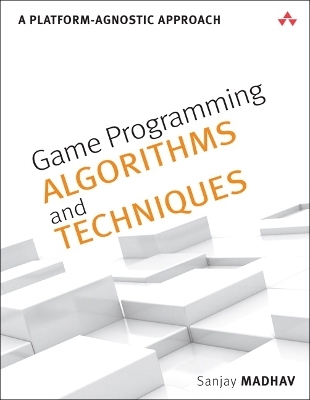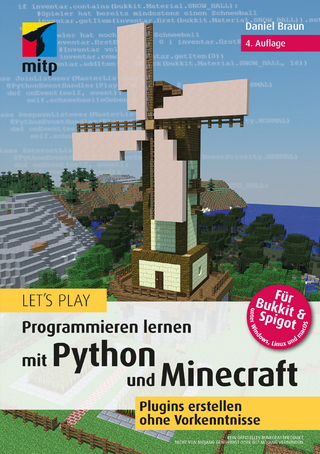
Game Programming Algorithms and Techniques
Addison-Wesley Educational Publishers Inc (Verlag)
978-0-321-94015-5 (ISBN)
Sanjay Madhav takes a unique platform- and framework-agnostic approach that will help develop virtually any game, in any genre, with any language or framework. He presents the fundamental techniques for working with 2D and 3D graphics, physics, artificial intelligence, cameras, and much more.
Each concept is illuminated with pseudocode that will be intuitive to any C#, Java, or C++ programmer, and has been refined and proven in Madhav’s game programming courses at the University of Southern California. Review questions after each chapter help solidify the most important concepts before moving on.
Madhav concludes with a detailed analysis of two complete games: a 2D iOS side-scroller (written in Objective-Cusing cocos2d) and a 3D PC/Mac/Linux tower defense game (written in C# using XNA/ MonoGame). These games illustrate many of the algorithms and techniques covered in the earlier chapters, and the full source code is available at gamealgorithms.net.
Coverage includes
Game time management, speed control, and ensuring consistency on diverse hardware
Essential 2D graphics techniques for modern mobile gaming
Vectors, matrices, and linear algebra for 3D games
3D graphics including coordinate spaces, lighting and shading, z-buffering, and quaternions
Handling today’s wide array of digital and analog inputs
Sound systems including sound events, 3D audio, and digital signal processing
Fundamentals of game physics, including collision detection and numeric integration
Cameras: first-person, follow, spline, and more
Artificial intelligence: pathfinding, state-based behaviors, and strategy/planning
User interfaces including menu systems and heads-up displays
Scripting and text-based data files: when, how, and where to use them
Basics of networked games including protocols and network topology
Sanjay Madhav is a lecturer at the University of Southern California, where he teaches several courses about and related to video game programming. Prior to joining USC full time, he worked as a programmer at several video game developers, including Electronic Arts, Neversoft, and Pandemic Studios. Although he has experience programming a wide range of systems, his primary interest is in gameplay mechanics. Some of his credited games include Medal of Honor: Pacific Assault, Tony Hawk’s Project 8 , Lord of the Rings: Conquest , and The Saboteur . In 2008, Sanjay began teaching part-time at USC while still working full time in the game industry. After Pandemic Studios was shuttered at the end of 2009, he decided to refocus his efforts on teaching up-and-coming game programmers. His flagship course is an undergraduate-level game programming course that he has taught for more than ten consecutive semesters.
Preface xv
1 Game Programming Overview 1
Evolution of Video Game Programming 2
The Game Loop 5
Time and Games 9
Game Objects 13
Summary 15
Review Questions 16
Additional References 16
2 2D Graphics 19
2D Rendering Foundations 20
Sprites 22
Scrolling 30
Tile Maps 35
Summary 39
Review Questions 39
Additional References 39
3 Linear Algebra for Games 41
Vectors 42
Matrices 58
Summary 62
Review Questions 62
Additional References 63
4 3D Graphics 65
Basics 66
Coordinate Spaces 67
Lighting and Shading 76
Visibility 85
World Transform, Revisited 88
Summary 91
Review Questions 92
Additional References 92
5 Input 93
Input Devices 94
Event-Based Input Systems 99
Mobile Input 105
Summary 108
Review Questions 108
Additional References 109
6 Sound 111
Basic Sound 112
3D Sound 115
Digital Signal Processing 119
Other Sound Topics 122
Summary 124
Review Questions 125
Additional References 125
7 Physics 127
Planes, Rays, and Line Segments 128
Collision Geometry 130
Collision Detection 134
Physics-Based Movement 148
Physics Middleware 153
Summary 154
Review Questions 154
Additional References 155
8 Cameras 157
Types of Cameras 158
Perspective Projections 161
Camera Implementations 164
Camera Support Algorithms 175
Summary 178
Review Questions 178
Additional References 178
9 Artificial Intelligence 179
“Real” AI versus Game AI 180
Pathfinding 180
State-Based Behaviors 192
Strategy and Planning 198
Summary 200
Review Questions 200
Additional References 202
10 User Interfaces 203
Menu Systems 204
HUD Elements 207
Other UI Considerations 217
Summary 221
Review Questions 222
Additional References 222
11 Scripting Languages and Data Formats 223
Scripting Languages 224
Implementing a Scripting Language 229
Data Formats 235
Case Study: UI Mods in World of Warcraft 239
Summary 241
Review Questions 241
Additional References 242
12 Networked Games 243
Protocols 244
Network Topology 250
Cheating 255
Summary 257
Review Questions 257
Additional References 258
13 Sample Game: Side-Scroller for iOS 259
Overview 260
Code Analysis 262
Exercises 267
Summary 268
14 Sample Game: Tower Defense for PC/Mac 269
Overview 270
Code Analysis 273
Exercises 284
Summary 285
A Answers to Review Questions 287
Chapter 1: Game Programming Overview 288
Chapter 2: 2D Graphics 289
Chapter 3: Linear Algebra for Games 290
Chapter 4: 3D Graphics 291
Chapter 5: Input 292
Chapter 6: Sound 294
Chapter 7: Physics 295
Chapter 8: Cameras 295
Chapter 9: Artificial Intelligence 296
Chapter 10: User Interfaces 298
Chapter 11: Scripting Languages and Data Formats 299
Chapter 12: Networked Games 300
B Useful Tools for Programmers 303
Debugger 304
Source Control 309
Diff and Merging Tools 312
Issue Tracking 313
Index 315
| Erscheint lt. Verlag | 7.1.2014 |
|---|---|
| Reihe/Serie | Game Design |
| Verlagsort | New Jersey |
| Sprache | englisch |
| Maße | 178 x 228 mm |
| Gewicht | 646 g |
| Themenwelt | Kinder- / Jugendbuch ► Sachbücher |
| Informatik ► Software Entwicklung ► Spieleprogrammierung | |
| Informatik ► Weitere Themen ► Computerspiele | |
| ISBN-10 | 0-321-94015-6 / 0321940156 |
| ISBN-13 | 978-0-321-94015-5 / 9780321940155 |
| Zustand | Neuware |
| Informationen gemäß Produktsicherheitsverordnung (GPSR) | |
| Haben Sie eine Frage zum Produkt? |
aus dem Bereich


